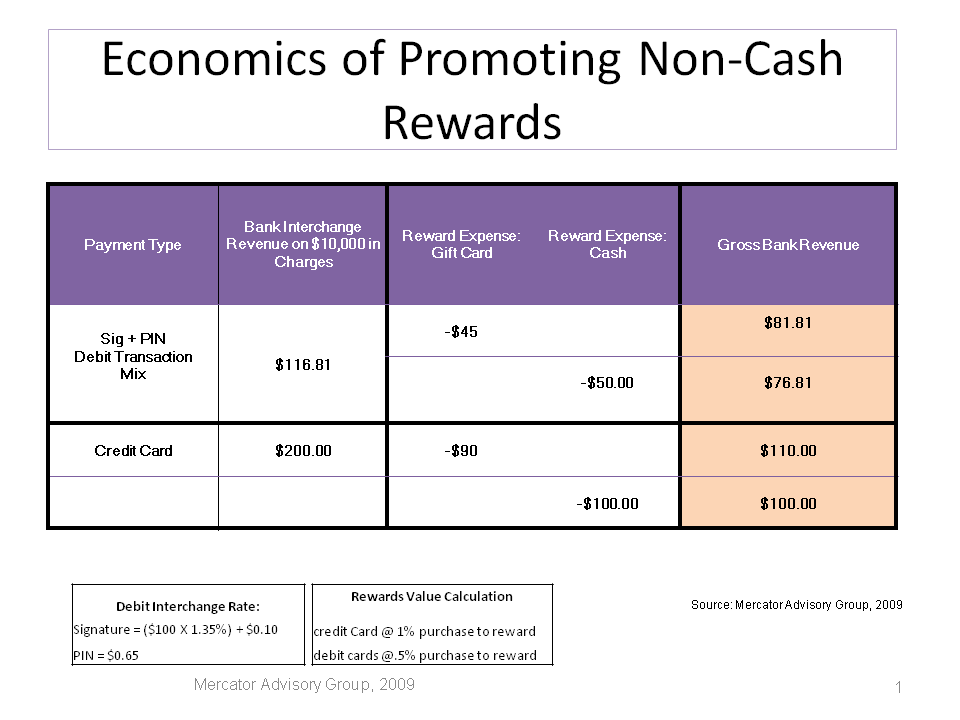Overview
RESEARCH EXAMINES ESCALATING COMPETITION IN
BANK REWARDS/LOYALTY SECTOR
Weaponizing Loyalty: New Schemes Bolster
Bank Competitiveness
A new report from Mercator Advisory Group's Retail Banking Practice, Weaponizing Loyalty: New Schemes Bolster Bank Competitiveness offers an in-depth examination of bank loyalty initiatives vitally relevant in today's banking environment. These new rewards/loyalty initiatives are supported by a new crop of loyalty vendors offering financial institutions, and their merchant partners, the ability to parse bank customer transactional data to craft customized rewards across a spectrum of deposit products. These services will change the competitive landscape of the retail banking industry.
By year end 2010, Mercator Advisory Group predicts that 360 degree relationship-based loyalty programs will be the New Normal within the banking industry and that merchant funded co-branding, deposit account-based rewards programs and promotion individuation will become the hallmarks of these programs.
Weaponizing Loyalty: New Schemes Bolster Bank Competitiveness examines how to turn the notional concept of customer loyalty into a dynamic feature of the day-to-day life of a bank and how bank's can "dynamicize" loyalty to serve not just as a retention tool, but to become a bank's most import competitive weapon.
A challenge program designers face is that customers have an explicit preference for cash-back rewards programs but banks realize their greatest ROI on points/miles-based programs featuring products/flights as redemption objectives.
It is Mercator Advisory Group's position that loyalty/rewards program managers can retain products (including gift card) as a preferred reward by enriching their programs one of two ways: they can harness the synergies of merchant funded networks or they can turn the ROI modeling of their programs on its head.
"Rewards Checking was the first mainstream banking product that directly correlated paying high interest rates on checking accounts with specific banking channel usage. That model is being enhanced by new vendors leveraging merchant funded discount networks and their rich cash-back/discounts to make specific demands of customers." comments Elizabeth Rowe, Group Director of Mercator Advisory Group's Banking Advisory Services and author of the report. "The next feature of increasingly sophisticated bank loyalty programs is customizing rewards and cash back bonus percentages to mirror account balances/transactions, channel usage and age/loyalty of the account."
Report Highlights Include:
1. This report examines issues and strategies affecting the overall profitability and margins of bank rewards programs; new vendor offerings driving bank customer behaviors in ingenious ways by touching each account and payment method of that relationship; and the loyalty communications that can be deployed to captivate new customers and nurture long standing customer relationships.
2. Many smaller banks ($10 billion) report a surge in new customers coming through their doors. In fact, much of that new business is only offsetting their losses in core deposits in late 2007. Acquiring and growing new accounts is critical to this segment as they work to optimize opportunities against larger competitors.
3. Overdrafts continue to be the engine of cash generation for the commercial banking industry and overdraft income will increase at least 15% for 2009. Rather than dramatically raising first incident overdraft fees, banks will escalate the frequency of triggering events and raise the incremental cost of each additional overdraft item. Fortification of rewards and loyalty programs is required to overcome the ill-will generated by overdraft fees.
4. Loyalty initiatives should focus on online customers (both bill pay and non-bill pay customers). They are banks' most active and profitable retail banking customers. At a minimum, they are 20% more profitable than offline customers, almost 30% of them have household incomes greater than $100,000 and Fiserv has just found that active online bill payers carry 79% higher account balances than average customers.
5. Tiers within rewards/loyalty programs should reflect both the number of DDA transactions and the dollar values of those transactions. With an overarching wrap of years of account ownership, programs naturally cost-sort themselves so that low dollar, infrequent transactions by new account holders receive the lowest number of points while big spending loyal customers are most generously rewarded.
One of the 14 Exhibits included in this report:

Companies Mentioned in This Report: American Express, Bank of America, Cardlytics, Citibank, Discover Financial, First Citizen???s Bank of Canada, First Data, Fiserv, HSBC Direct, Jack Henry, Madison Credit Union, PNC Financial Services Group, PULSE, Saylent Technologies and Vesdia Corp.
This report contains 31 pages and 14 exhibits
Members of Mercator Advisory Group have access to these reports as well as the upcoming research for the year ahead, presentations, analyst access and other membership benefits.
Please visit us online at www.mercatoradvisorygroup.com.
For more information and media inquiries, please call Mercator Advisory Group's main line: 781-419-1700 or send E-mail to [email protected].
Mercator Advisory Group is the leading, independent research and advisory services firm exclusively focused on the payments industry. We deliver pragmatic and timely research and advice designed to help our clients uncover the most lucrative opportunities to maximize revenue growth and contain costs. Our clients range from the world's largest payment issuers, acquirers, processors, and associations to leading technology providers.
Book a Meeting with the Author
Make informed decisions in a digital financial world